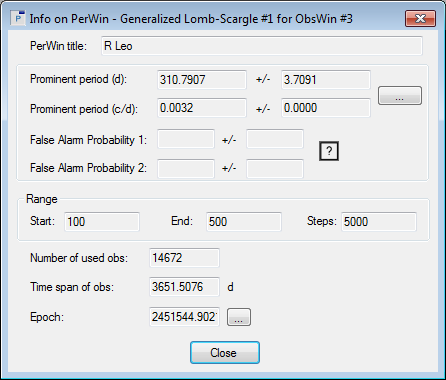|
Displays the Info form of the active Period Window. The Info form groups general information about the periodogram present in the PerWin. It consists of following sections:

- PerWin title: displays the title of the active Period Window.
- Prominent period: displays the value of the dominant period in the Period Window, expressed both in cycles per day (c/d) and days (d), and calculated following the selected period analysis method. Next to the period value, also the period uncertainty or period error is given, in the field following the +/- symbol. In case the Period Window has been calculated with Frequency as Unit, the prominent period values are expressed in cycles per hour (c/h) and hours (h). Peranso determines the period error as described in the corresponding section.
- Click the button labeled "..." next to the Prominent period error fields to bring up the Mean Noise Power Level (MNPL) form.
- False Alarm Probability 1 and 2: used to express the significance of the dominant period. Click the
 button for a brief explanation on the meaning of the False Alarm Probabilities. button for a brief explanation on the meaning of the False Alarm Probabilities.
- Range: displays the start and end values, as well as the number of Steps that were used to define the period scan range at the moment the Period Window was created. They are expressed in the same unit and base as the prominent period (d, c/d, h or c/h).
- Number of used obs: indicates how many observations have been used for the period analysis.
- Time span of obs: the difference between the time of the last observation and the time of the first observation, used in the period analysis.
- Epoch: by default Peranso uses the Julian Date of the first active and not fainter-than observation in the ObsWin as epoch time. This is the starting time used for calculating the phases of a Phase Window. It is propagated to all child Phase Windows of the current Period Window. Click the button labeled "..." next to the Epoch field to bring up the Epoch Form, which allows to enter a different value.
- Click the Close button to remove the Info form.
The following fields are optional and depend upon the selected period analysis method:
- Nb, Nc: displays the number of bins (Nb) and covers of bins (Nc) parameters entered for a PDM, EEBLS (Nb only), Phase-binned AoV and AoV Transit period analysis.
- Number harmonics : displays the number of harmonics used for an ANOVA or FALC period analysis.
- Default Mag error: displays the default brightness error value used for a FALC period analysis.
- Observational Mag error : displays the observational brightness error value used for a Renson period analysis.
- Min and Max frac transit length: the fractional transit length is assumed to be a small number (usually between 0.01 and 0.05) and denotes the time spent in the transit phase, relative to the total transit duration. Used in EEBLS.
The following fields are displayed when doing an EEBLS period analysis :
- the epoch of mid transit
- the transit depth
- the transit duration
- the phase of ingress (transit start)
- the phase of egress (transit end)
|
